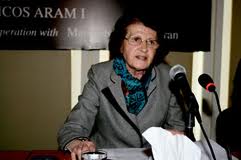The 14th century is one of the important phases in the history of medieval Armenian art, the interesting stage of true creative aspirations. A most remarkable and original representative of this period is the painter Avag.
Schools of higher education and their adjacent studios which were organized in Eastern Armenia in the 13-14lh centuries, have left an ineffaceable imprint on the history of Armenian culture. In such a school as the University of Gladzor, the painter Avag received his education, having the renowned scientist Yesayi Nchetsi as a teacher. We know neither the place nor the date of his birth. Avag belonged to the category of wandering artists so widely spread in the late Middle Ages. While travelling, these artists adopted the best achievements of various arts which were afterwards creatively elaborated due to their undeniably great individuality. Gladzor, Sultanya, Maragha, Paitakaran, and finally Cilicia are the names of places where Avag found temporary refuge and worked. In the fifties of the 14th cent, he visited Cilicia, when its fame had already begun to decline, yet, the spirit of artistic life still lingered on in the great cities. In Cilicia the painter had ample opportunity to become acquainted with Byzantine and Western manuscripts; he came into contact with the upper class having European orientation, being charmed by their luxurious and magnificent attire, and also observing a life and customs so unusual for him. As Avag was truly an artist of great talent and individuality, his creations never lost their national features.
Seven manuscripts of Avag's artistic heritage have survived. The miniatures of these manuscripts reveal an art which is rich in traditional forms, in expressions of a modern style and in original researches. In Avag's paintings the feeling of classical art is revealed either in single characters or in the whole composition and in the making of the page; it is also felt in the role colour plays in the entire complex. But in Armenian miniature painting of the 14 cent, no artist surpassed Avag's mastership in representing the human figure from different points, in various positions and places. This is the most important novelty brought into the art of Armenian illumination by this talented artist who continued and completed the main trends of Roslin's art.
In Avag's work we see the almost definite qualities of the new progressive style characteristic of the 14th cent. Avag is among these exceptional miniaturists in whose creations the new style, adopted by Armenian art as a whole, is wonderfully expressed. In his innovations he is bold and unyielding. Both the content and stylistic bases of his art are so dynamic that analogies are spontaneously drawn with Paleologue Art, one of the most widely spread trends of that time. This is the reason why Avag's artistic heritage acquires great importance in Armenian miniature painting. On the whole, it is a phenomenon proving the harmony between the changes taking place in the 14th cent. Armenian culture and the artistic achievements of the Christian world.
LILITH ZAKARIAN

